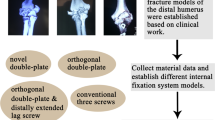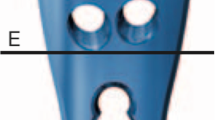Abstract
Background
The objective of this study was to determine the in vitro characteristics of the clinically used and newly developed implants for the stabilization of proximal humeral fractures under static and cyclic loading. The goal was to optimize implant stiffness for fracture stabilization even in weak bone stock.
Methods
In a laboratory study using 35 fresh human humeri, the specimens were randomized into 5 groups, which included the clinically used humerus T-plate (HTP), the cross-screw osteosynthesis (CSO), the unreamed proximal humerus nail with spiral blade (UHN), the recently developed Synclaw Proximal Humerus Nail (Synclaw PHN) and the angle-stable Locking Compression Plate Proximal Humerus (LCP-PH). The implant stiffness was determined for three clinically relevant load cases: axial compression, torsion and varus bending. In addition, a cyclic varus-bending test was performed to determine the implant properties under cyclic loading.
Results
In contrast to a rather elastic and minimally invasive implant(LCP-PH), the conventionally designed ones (Synclaw PHN, CSO, HTP, UHN) showed rather high stiffness values under static loading. In cyclic loading, a strong decrease in stiffness (p<0.05) was found for the rigid implants HTP and UHN. In comparison with the other implants, only the elastic implant (LCP-PH) showed a significantly lower load reduction in a weak bone stock (17±6.2%).
Conclusion
The high initial stiffness of rigid implants led to an early loosening and failure of the implant-bone interface under cyclic loading. Implants with low stiffness and elastic characteristics, however, appear to minimize the peak stresses at the bone-implant interface, making them particularly suitable for fracture fixation in osteoporotic bone.







Similar content being viewed by others
References
Blum J, Rommens PM, Janzing H, Langendorff HS (1998) Retrograde Nagelung von Humerusschaftfrakturen mit dem UHN. Eine internationale multizentrische Studie. Unfallchirurg 101:342–352
Blum J, Machemer H, Hogner M, Baumgart F et al (2000) Biomechanik der Verriegelungsmarknagelung bei Oberarmschaftfrakturen. Vergleichsuntersuchung zweier Marknagelsysteme und des Effekts der interfragmentären Kompression beim unaufgebohrten Humerusnagel. Unfallchirurg 103:183–190
Dalton JE, Salkeld SL, Satterwhite YE, Cook SD (1993) A biomechanical comparison of intramedullary nailing systems for the humerus. J Orthop Trauma 7:367–374
Duda GN, Kirchner H, Wilke HJ, Claes L (1998) A method to determine the 3-D stiffness of fracture fixation devices and its application to predict inter-fragmentary movement. J Biomech 31:247–252
Henley MB, Monroe M, Tencer AF (1991) Biomechanical comparison of methods of fixation of a midshaft osteotomy of the humerus. J Orthop Trauma 5:14–20
Instrum K, Fennell C, Shrive N, Damson E et al (1998) Semitubular blade plate fixation in proximal humeral fractures: a biomechanical study in a cadaveric model. J Shoulder Elbow Surg 7:462–466
Koval KJ, Blair B, Takei R, Kummer FJ, Zuckerman JD (1996) Surgical neck fractures of the proximal humerus: a laboratory evaluation of ten fixation techniques. J Trauma 40:778–783
Koval KJ, Gallagher MA, Marsicano JG, Cuomo F et al (1997) Functional outcome after minimally displaced fractures of the proximal part of the humerus. J Bone Joint Surg Am 79:203–207
Lill H, Giers R, Schmidt A, Echtermeyer V (1996) Die dislozierte subkapitale Humerusfraktur. Operative Behandlung mit einer modifizierten Kirschner-Drahttechnik. Chir Praxis 50:427–438
Lill H, Lange K, Prasse-Badde J, Schmidt A et al (1997) Die T-Platten-Osteosynthese bei dislozierten proximalen Humerusfrakturen. Unfallchirurgie 23:183–192
Lill H, Korner J, Glasmacher S, Verheyden P et al (2001) Die gekreuzte Schraubenosteosynthese proximaler Humerusfrakturen. Unfallchirurg (in press)
Müller ME, Allgöwer M, Schneider R, Willenberger H (1992) Manual der Osteosynthese. Springer, Berlin Heidelberg New York
Naidu SH, Bixler B, Capo JT, Moulton MJ, Radin A (1997) Percutaneous pinning of proximal humerus fractures: a biomechanical study. Orthopedics 20:1073–1076
Rajesh MB, Manning P, Neumann L, Parry M, Wallace WA (2000) The effect of bone quality on intra-medullary fixation of the proximal humerus using a retrograde nail. Osteoporosis Int 11:45
Ruch DS, Glisson RR, Marr AW, Russell GB, Nunley JA (2000) Fixation of three-part proximal humeral fractures: a biomechanical evaluation. J Orthop Trauma 14:36–40
Sehr JR, Szabo RM (1988) Semitubular blade plate for fixation in the proximal humerus. J Orthop Trauma 2:327–332
Verheyden P, Streidt A, Lill H, Weise K, Josten C (1998) Der unaufgebohrte Humerusnagel—Indikationen, Technik und klinische Erfahrungen. Akt Traumatol 28:251–257
Weinstein DM, Gomez MA, Hawkins RJ (1994) Biomechanical comparison of tension-band wiring versus plating in the fixation of three-part fractures of the proximal humerus. Orthop Trans 18:3
Wheeler DL, Colville MR (1997) Biomechanical comparison of intramedullary and percutaneous pin fixation for proximal humeral fracture fixation. J Orthop Trauma 11:363–367
Williams GR Jr, Copley LA, Iannotti JP, Lisser SP (1997) The influence of intramedullary fixation on figure-of-eight wiring for surgical neck fractures of the proximal humerus: a biomechanical comparison. J Shoulder Elbow Surg 6:423–428
Zimmerman MC, Waite AM, Deehan M, Tovey J, Oppenheim W (1994) A biomechanical analysis of four humeral fracture fixation systems. J Orthop Trauma 8:233–239
Acknowledgements
We thank Prof. Reinhard Vock (†) from the Department of Forensic Medicine and Prof. Christian Wittekind from the Department of Pathology of the University of Leipzig, Germany, and Jan-Eric Hoffmann for support in mechanical testing. This study was supported by a grant of the Robert Mathys Foundation, Switzerland, and the Richard Maatz grant 1999 of the Gerhard Küntscher Society, Germany.
Author information
Authors and Affiliations
Corresponding author
Rights and permissions
About this article
Cite this article
Lill, H., Hepp, P., Korner, J. et al. Proximal humeral fractures: how stiff should an implant be?. Arch Orthop Trauma Surg 123, 74–81 (2003). https://doi.org/10.1007/s00402-002-0465-9
Received:
Published:
Issue Date:
DOI: https://doi.org/10.1007/s00402-002-0465-9




